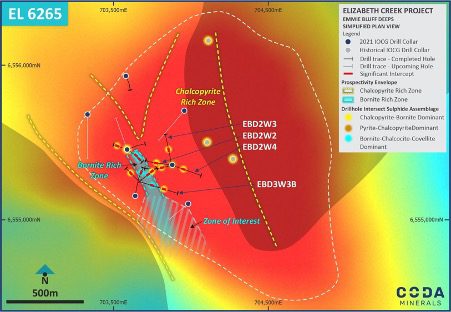Coda Minerals Limited (ASX: COD) has logged thick copper-sulphide mineralised intercepts in four new holes extending the mineralised envelop to the north, east and south with the ongoing IOCG drilling programme at Emmie Bluff Deeps, part of its Elizabeth Creek Project in South Australia.
In early June 2021, Coda announced that its first diamond drillhole at Emmie Bluff Deeps IOCG target, DD21EB0018, had intersected 200m of intense IOCG alteration including approximately 50m of copper sulphide mineralisation.
In July 2021, the initial intersection was followed up by announcement of visual estimates from two wedge (daughter) holes drilled from the parent hole which demonstrated a significant intersection of high-grade bornite dominant copper mineralisation in Wedge 2.
Subsequent assaying results confirmed the intersection of two mineralised lodes, namely 24m at 2.2% Cu and 0.3g/t Au and 13m at 3.5% Cu and 0.6g/t Au.
In October 2021, the results from five additional drill holes, (two parent and three wedge holes) demonstrated a material increase to the lateral extent of the mineralisation.
Holes EBD2 (parent) and EBD2W2 (wedge) demonstrated a significant increase in the thickness and intensity of visual sulphides. EBD3W2 returned a 67m intersection of intermixed bornite and chalcopyrite copper mineralisation (assays pending). –
These two bornite-dominant intersections demonstrated the presence of a higher grade bornite-rich core within an overall laterally extensive chalcopyrite halo at Emmie Bluff Deeps.
At the time of finalising this announcement, assay results from the five drill holes, EBD2, EBD2W1, EBD3, EBD3W1 and EBD3W2, for which visual observations of mineralisation have been released to ASX, remain outstanding due to delays at assay laboratories.
The company expects to receive and release the majority of these results prior to Christmas 2021. Work Completed in October and November 2021
Since the release of the visual results from the holes outlined above, the company has focused on the following strategic objectives with its ongoing drilling programme:
Testing and extending the broader chalcopyrite-dominant halo of mineralisation identified in EBD2 with wedge holes drilled to the west (EBD2W2), north (EBD2W3) and east (EBD2W4); and
Testing and extending the higher grade bornite-dominant mineralisation, following the trend to the south-east from the parent hole through EB0018W2 and EBD3W2 with wedge hole EBD3W3.
“We have now had an outstanding run of nine holes from this and the previous drilling programme. All have returned materially important intersections and we are beginning to demonstrate a clear trend of increasing thickness and tenor of mineralisation as we systematically follow the bornite-dominant zone to the south-east,” CEO. Chris Stevens, said.
“In particular, the results from EBD3W3B are exceptional. Once confirmed by assays, this hole will not only materially extend the known bornite-dominated zone but should also give us one of our thickest sulphide intersections to date.
“It also appears to have identified at least one major mineralising structure, providing a significantly improved structural understanding of the deposit – and possible vectors towards a basement-tapping source or ‘pipe’ structure.
“The drilling to date has already delineated an extensive mineralised zone which remains wide open to the south – and the intercepts in EBD2W3 and 2W41 also show that it is also open to the north and east. In fact, the lateral extent of the mineralisation is largely unconstrained in almost every direction.
“Our short-term focus will be to continue to follow the highest grade bornite dominated mineralisation to the south-east, while at the same time continuing to test the mineralisation in as many directions as possible over the coming months.
“The strategy of cautiously stepping out and using a combination of parent and wedge holes to gain an understanding of trends within the mineralised area has achieved exactly what we hoped. We will now start to step out increasing distances, with EBD4 being the next planned parent hole from surface potentially extending the bornite dominated zone by over 250m to the south-east.
“With numerous assays due this month, and a maiden Mineral Resource Estimate for the Emmie Bluff Zambian-style copper-cobalt deposit on track for release before the end of the year, we expect 2021 to finish up as a transformational year for Coda Minerals.
“The board has now approved an ambitious ongoing exploration programme which is underpinned by a strong cash balance of A$17.8M as at the end of the September quarter; we are looking forward to our exciting discovery journey continuing well into 2022.”
For further information please visit: https://www.codaminerals.com/












